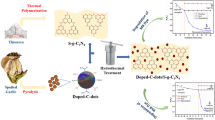Abstract
Dye sensitized solar cells or “Grätzel” cells are electrochemical devices capable of performing the direct conversion of light into electricity and are less expensive than traditional silicon solar cells. The most efficient dyes for Grätzel cells are those composed by the coordination compounds of ruthenium ions, which have high cost due to the shortage of ruthenium (Ru) element in the Earth’s crust. Thus, the study of dyes with lower cost is crucial for the viability of this technology on a large scale. Natural dyes are easily extracted in addition to being environmentally friendly and presenting reduced cost. Anthocyanins are the most important pigments of vascular plants, providing color to the flowers and fruits. In grapes, anthocyanins are found exclusively in the skin and can be easily extracted with ethanol at room temperature. In this work we used the ethanolic extract of anthocyanins from Vitis labrusca grape in the sensitization of TiO2 electrodes and production of a Grätzel cell. The prepared Grätzel cell presents a short-circuit current of 0.045 mA/cm2, above that of the cell sensitized with commercial N719 dye, which was 0.032 mA/cm2. However, the open circuit voltage was 0.293 V, lower than that sensitized with N719 (0.335 V). The fill factor of the anthocyanin sensitized cell was 46.19 %, higher than that of the N719 sensitized cell, 42.72 %. These results are consistent with the greater absorption of light radiation observed in the cell with grape anthocyanins in comparison with the cells sensitized with N719 dye.






Similar content being viewed by others
References
A. Hagfeldt, G. Boschloo, L. Sun, L. Kloo, H. Pettersson, Chem. Rev. 110, 6595 (2010)
B. O’Regan, M. Grätzel, Nature 353, 737 (1991)
C. Longo, M.A. de Paoli, J. Braz. Chem. Soc. 14, 889 (2003)
T.V. Arjunan, T.S. Senthil, Mater. Technol. 28, 9 (2013)
A. Castañeda-Ovando, M.D.L. Pacheco-Hernándes, M.E. Páez-Hernández, J.A. Rodríguez, C.A. Galán-Vidal, Food Chem. 113, 859 (2009)
S.V. Raghvendra, A. Shakya, M. Hedaytullah, G.S. Arya, A. Mishra, A.D. Grupta, A.P. Pachpute, D. Patel, Int. J. Pharm. Sci. Rev. Res. 6, 28 (2011)
I. Iosub, F. Kajzar, M. Makowska-Janusik, A. Meghea, A. Tane, R. Ileana, Opt. Mater. 34, 1644 (2012)
M.J. Carnie, C. Charbonneau, P.R.F. Barnes, M.L. Davies, I. Mabbett, T.M. Watson, B.C. O’Regan, D.A. Worsley, J. Mater. Chem. A 1, 2225 (2013)
M.C. Kao, H.Z. Chen, S.L. Young, C.Y. Kung, C.C. Lin, Thin Solid Films 517, 5096 (2009)
I. Shin, H. Seo, M.K. Son, J.K. Kim, K. Prabakar, H.J. Kim, Curr. Appl. Phys. 10, 422 (2010)
R. Lópes, R. Gómes, J. Sol-Gel. Sci. Technol. 61, 1 (2012)
N. Gokilamani, N. Muthukumarasamy, M. Thambidurai, A. Ranjitha, V. Dhayalan, T.S. Senthil, R. Balasundaraprabhu, J. Mater. Sci. Mater. Electron. 24, 3394 (2013)
J. Gong, J. Liang, K. Sumathy, Renew. Sustain. Energ. Rev. 16, 5848 (2012)
Z. Lan, J. Wu, D. Wang, S. Hao, J. Lin, Y. Huang, Sol. Energ. 81, 117 (2007)
A. Subramanian, C.Y. Ho, H. Wang, J. Alloy. Compd. 572, 11 (2013)
Acknowledgments
Authors are thankful to the CLABMU-UEPG for the measurements carried out and the financial support of CAPES/PNPD, Fundação Araucária and CNPq.
Author information
Authors and Affiliations
Corresponding author
Rights and permissions
About this article
Cite this article
Szostak, R., de Souza, E.C.F., Antunes, S.R.M. et al. Anthocyanin from Vitis labrusca grape used as sensitizer in DSSC solar cells. J Mater Sci: Mater Electron 26, 2257–2262 (2015). https://doi.org/10.1007/s10854-015-2678-z
Received:
Accepted:
Published:
Issue Date:
DOI: https://doi.org/10.1007/s10854-015-2678-z




